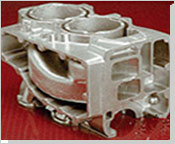 This process utilizes, a metal as the mold material. Ideally cast iron or Meehanite (a dense cast iron) is used. Metal or sand is used for cores. Thin layers of Clay or sodium silicate is used for coating the cavity surfaces, as they are heat resistant. The molds are pre-heated at a temperature upto 200ºC (392ºF) before the metal is poured into the cavity. Proper precaution is needed for ensuring thermal balance. This can be facilitated by using external water cooling or suitable radiation techniques.
This process utilizes, a metal as the mold material. Ideally cast iron or Meehanite (a dense cast iron) is used. Metal or sand is used for cores. Thin layers of Clay or sodium silicate is used for coating the cavity surfaces, as they are heat resistant. The molds are pre-heated at a temperature upto 200ºC (392ºF) before the metal is poured into the cavity. Proper precaution is needed for ensuring thermal balance. This can be facilitated by using external water cooling or suitable radiation techniques.
- Allows use of different patterns.
- Lowers cost of production, although that depends upon the complexity of the part produced.
- Wall Thickness - typical considerations apply here such as 3mm for lengths under 75 mm), radius (inside radius = nominal wall thickness, outside radius = 3 x nominal wall thickness)
- Draft Angles - 1 to 3º on outside surfaces, 2 to 5º on inside surfaces)
- Tolerance is 2% of linear dimensions.
- Surface Finish ranges from 2.5 µm to 7.5 µm (100 µin to 250 µin).
- Part Sizes range from 50 g to 70 kg (1.5 ounces to 150 lb).
- Casting method is clean with little waste and no fumes. The process avoids the contamination problems that generally sand foundries deal with.
Application of Permanent Mold Cast:
Most common materials used are small and medium sized parts made of aluminum, magnesium and brass. Products include gears, splines, wheels, gear housings, pipe fittings, fuel injection housings, and automotive engine pistons.
Permanent Mold Castings can take various forms such as: Slush CastingA special type of permanent mold casting, where the molten metal is not solidified completely. After obtaining the desired wall thickness the semi- solidified molten metal is poured out.
Useful for making hollow ornamental objects such as lamps, candlesticks, statues etc.
Low Pressure Permanent Mold CastingYet another variation of the permanent mold casting. Instead of using gravity to help in the metal pour and flow, a low pressure of 1 atmosphere gas is applied to the molten metal. The pressure on the melt causes the mold to be completely filled up and compensates for any shrinkage on cooling. Mechanical properties are superior to permanent mold casting by about 5%.
Vacuum Permanent Mold CastingAlso a variation of the permanent mold casting. Thin wall castings can be made here. The yields are generally high since no risers are used. The mechanical properties are better than the traditional permanent mold casting by 10-15% Castings sizes can range from 200 g to 4.5 kg (6 oz to 10 lb).
